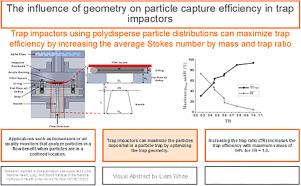几何形状对捕集器粒子捕获效率的影响
IF 2.9
3区 环境科学与生态学
Q2 ENGINEERING, CHEMICAL
引用次数: 0
摘要
在本研究中,捕集器用于收集多分散液滴,并与传统惯性冲击器预测的效率进行了比较,结果非常吻合。多分散液滴被雾化,直径从0.3μm到10.5μm不等。用光学粒度仪对冲击喷嘴后的液滴进行表征,以确定在测试流速下的粒径分布和相应的斯托克斯数(St)分布。疏水阀的比率定义为疏水阀和喷嘴直径之差除以疏水阀的总深度。为了表征陷阱的几何形状,对多个陷阱进行了不同陷阱比率的测试,结果表明,降低陷阱比率会导致陷阱效率降低和壁面损失增加。具体来说,当捕集器比为1.00时,捕集器效率最高可达94%,而当捕集器比为0.27时,捕集器效率最高可达31%。提出了疏水阀冲击器的设计建议,通过增加疏水阀的比例来最大化疏水阀内的液滴收集。本文章由计算机程序翻译,如有差异,请以英文原文为准。

The influence of geometry on particle capture efficiency in trap impactors
In this study, trap impactors are used to collect polydisperse liquid droplets and are compared to the efficiency predicted by a conventional inertial impactor with excellent agreement. Polydisperse droplets are atomized and vary from to in diameter. Droplets are characterized after the impactor nozzle with an optical particle sizer to determine the size distribution and the corresponding distribution of Stokes numbers (St) at the tested flow rates. The trap ratio is defined as the difference between the trap and nozzle diameters divided by the total depth of the trap. To characterize the trap geometry, multiple traps are tested with varying trap ratios and demonstrate that decreasing the trap ratio results in a reduction in trap efficiency and an increase in wall losses. Specifically, a trap ratio of 1.00 resulted in a maximum trap efficiency of 94%, whereas a trap ratio of 0.27 had a maximum trap efficiency of 31%. Trap impactor design recommendations are made to maximize droplet collection inside the trap by increasing the trap ratio.
求助全文
通过发布文献求助,成功后即可免费获取论文全文。
去求助
来源期刊

Journal of Aerosol Science
环境科学-工程:化工
CiteScore
8.80
自引率
8.90%
发文量
127
审稿时长
35 days
期刊介绍:
Founded in 1970, the Journal of Aerosol Science considers itself the prime vehicle for the publication of original work as well as reviews related to fundamental and applied aerosol research, as well as aerosol instrumentation. Its content is directed at scientists working in engineering disciplines, as well as physics, chemistry, and environmental sciences.
The editors welcome submissions of papers describing recent experimental, numerical, and theoretical research related to the following topics:
1. Fundamental Aerosol Science.
2. Applied Aerosol Science.
3. Instrumentation & Measurement Methods.
 求助内容:
求助内容: 应助结果提醒方式:
应助结果提醒方式:


